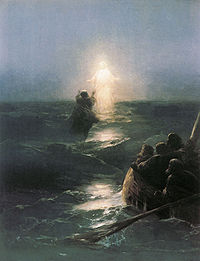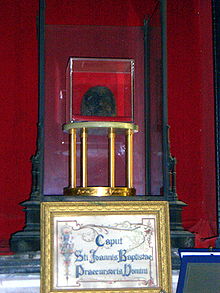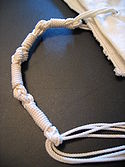- Mark 6
-
This article is about the chapter of the Book of Mark. For other uses, see Mark VI.
Gospel of Mark Mark 6 is the sixth chapter of the Gospel of Mark in the New Testament of the Christian Bible.
Contents
Rejection of Jesus at Nazareth
See also: Rejection of JesusMark relates the story, also found in Matthew 13:53-58 and probably Luke 4:14-30, of Jesus's rejection at Nazareth. The people question his authority and don't seem to think much of the Jesus they remember or his family. "Isn't this the carpenter? Isn't this Mary's son and the brother of James, Joseph, Judas and Simon? Aren't his sisters here with us?" Jesus replies "Only in his hometown, among his relatives and in his own house is a prophet without honor."
Jesus's brothers are here and in Matthew and probably Acts 12:17 mentioned by name, though not his sisters. This chapter, coupled with Mark 3:21,31-35 paint a negative view of Jesus's family relations, though other sources, such as Galatians 1:19 show that James was at least active in the early Church after Jesus's crucifixion. The negative view of Jesus' family may be related to the conflict between Paul and Jewish Christians.[1]
Mission of the Twelve and the death of John the Baptist
Jesus sends the Twelve (the Twelve Apostles) out to the various towns, in pairs, to heal the sick and drive out demons. They are only to take their staffs and that if any town rejects them "...shake the dust off your feet when you leave, as a testimony against them." (11) which is "...a gesture both of contempt and of warning."[2]
Mark then tells of the death of John the Baptist at the hands of Herod Antipas. Herod is married to his wife Herodias, former wife of his brother Herod Philip I. John condemns Herod so Herod incarcerates John. Herodias seeks revenge on John during a birthday party for Herod. Her daughter dances for Herod and persuades Herod to kill John. John's disciples take his body and put it in a tomb. This is also found in Matthew 14:1-12. The year in which John died is unknown. Josephus has Herod killing John to quell a possible uprising around AD 36. Herod Philip died in 34 and Herod Antipas died sometime after 40 after being exiled to either Gaul or Spain.
Feeding of the five thousand and walking on water
Main articles: Feeding the multitude and Walking on water Walking on water, by Ivan Aivazovsky (1888).
Walking on water, by Ivan Aivazovsky (1888).
Mark then relates two miracles of Jesus. The "apostles" come back (regroup) and Jesus takes them on a boat. Verse 6:30 may be the only time Mark uses the word "apostle", which is most frequently (68 out of 79) used by Luke the Evangelist and Paul of Tarsus, see Strong's G652. When they land people are already waiting for them. Jesus teaches them several unrecorded things, then feeds the entire crowd of 5,000 people by turning five loaves of bread and two fish into enough food to feed everyone.
Jesus sends the disciples in a boat ahead of him to Bethsaida. It is night and they are only half way across when Jesus walks across the lake and meets them. At first they are scared and think it is a ghost, but Jesus reveals himself and gets into the boat, amazing the disciples.
These two miracles occur in John 6:1-24 and Matthew 14:13-36 and the feeding of the crowd is in Luke 9:10-17.
The feeding of the 5,000 people and the resurrection of Jesus appear to be the only miracles recorded simultaneously in all four Gospels.[3]
Healing of the sick of Gennesaret
They reach Gennesaret and people recognize Jesus. People bring sick people on mats to wherever they hear Jesus is. They beg him to let them touch him, even only touching the "fringe of his cloak"[4] (6:56NRSV), and all the people who do so are healed. Jesus seems willing to help all who ask for it.[5] Raymond E. Brown argued that this section leaves readers suspecting that such enthusiasm for healing is not the right comprehension of or faith in Jesus.[6] This section is an example of a Marcan summary, in which several stories about Jesus are all wrapped up into one description. They help show the magnitude of his power and perhaps the nature of the danger the authorities see him as presenting to the public order.[5]
Notes
- ^ http://www.jesuspolice.com/common_error.php?id=11 "Wilson (1992) [Wilson, A.N. Jesus: A life. 1992. New York: Norton & Co.] has hypothesized that the negative relationship between Jesus and his family was placed in the Gospels (especially in the Gospel of Mark) to dissuade early Christians from following the Jesus cult that was administered by Jesus’ family. Wilson says: “…it would not be surprising if other parts of the church, particularly the Gentiles, liked telling stories about Jesus as a man who had no sympathy or support from his family (p. 86).” Butz (2005) [Butz, Jeffrey. The brother of Jesus and the lost teachings of Christianity. 2005. Rochester, Vermont: Inner Traditions.] is more succinct: “…by the time Mark was writing in the late 60s, the Gentile churches outside of Israel were beginning to resent the authority wielded by Jerusalem where James and the apostles were leaders, thus providing the motive for Mark’s antifamily stance… (p. 44).” Other prominent scholars agree (e.g., Crosson, 1973 [Crosson, John Dominic. “Mark and the relatives of Jesus”. Novum Testamentum, 15, 1973]; Mack, 1988 [Mack, Burton. A myth of innocence: Mark and Christian origins. 1988. Philadelphia: Fortress]; Painter. 1999 [Painter, John. Just James: The brother of Jesus in history and tradition. 1999. Minneapolis: Fortress Press])."
- ^ Miller 26
- ^ Burkett, Delbert. An Introduction to the New Testament and the Origins of Christianity. Cambridge University Press, 2002. ISBN 0521007208. Page 230.
- ^ Jewish Encyclopedia: Jesus: "Jesus wore the Ẓiẓit (Matt. ix. 20)"; Strong's Concordance G2899; Walter Bauer's Greek-English Lexicon of the NT, 3rd ed., 1979: "κράσπεδον: 1. edge, border, hem of a garment - But meaning 2 is also possible for these passages, dependending on how strictly Jesus followed Mosaic law, and also upon the way in which κράσπεδον was understood by the authors and first readers of the gospels. 2. tassel (ציצת), which the Israelite was obligated to wear on the four corners of his outer garment, according to Num 15:38f; Dt 22:12. ... Of the Pharisees ... Mt 23:5." See also Christianity and fringed garments.
- ^ a b Kilgallen 124
- ^ Brown 136
References
- Brown, Raymond E. An Introduction to the New Testament Doubleday 1997 ISBN 0-385-24767-2
- Kilgallen, John J. A Brief Commentary of the Gospel of Mark Paulist Press 1989 ISBN 0-8091-3059-9
- Mark 6 NIV Accessed 28 October 2005
- Miller, Robert J. The Complete Gospels Polebridge Press 1994 ISBN 0-06-065587-9
Chapters of the Bible Preceded by:
Mark 5 Gospel of Mark Followed by:
Mark 7 Categories:- Gospel of Mark chapters
Wikimedia Foundation. 2010.


